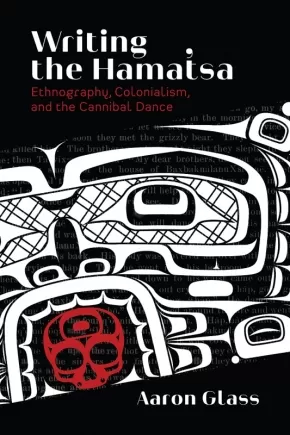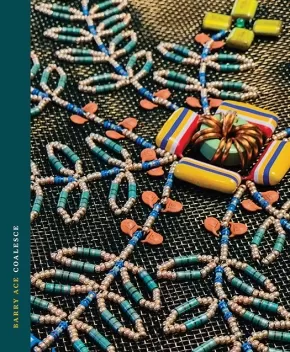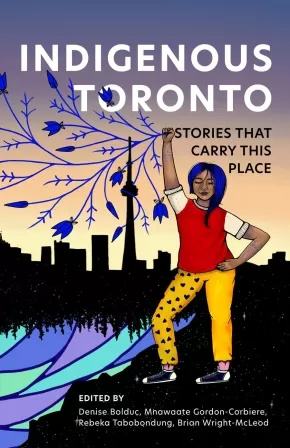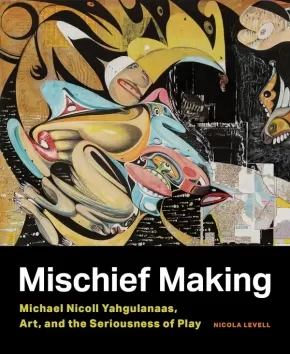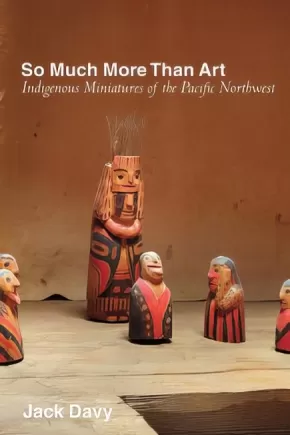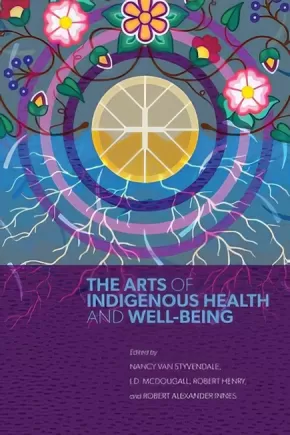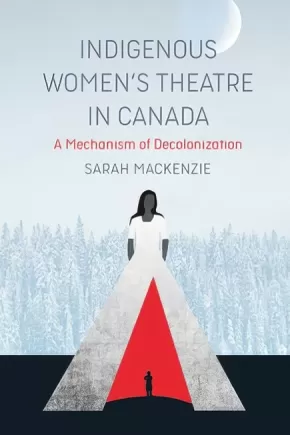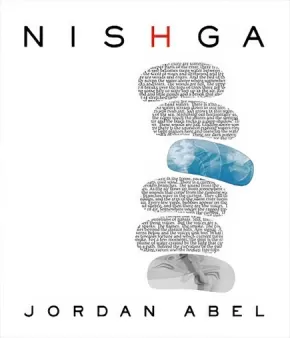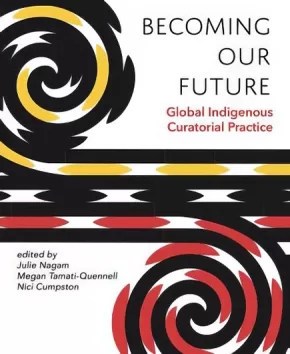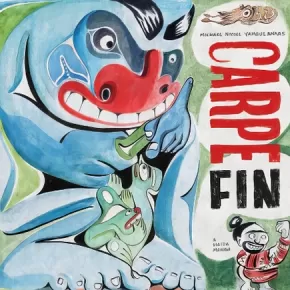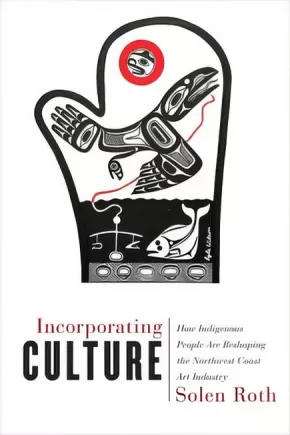
Art
46
-
60
of
89 Results;
Sort By
Go To
of 6
Writing the Hamat'sa: Ethnography, Colonialism, and the Cannibal Dance
$34.95
Format:
Paperback
Text Content Territories:
Indigenous Canadian; First Nations; Kwakwaka'wakw (Kwakiutl); Namgis; Salish; Coast Salish; K'omoks;
Reading Level: N/A
ISBN / Barcode: 9780774863780
Synopsis:
Synopsis:
Long known as the Cannibal Dance, the Hamat̓sa is among the most important hereditary prerogatives of the Kwakwa̱ka̱ꞌwakw of British Columbia. Writing the Hamat̓sa offers a critical survey of attempts to record, describe, and interpret the dance under shifting colonial policy. In the late nineteenth century, as anthropologists arrived to document the practice, colonial agents were pursuing its eradication and Kwakwa̱ka̱ꞌwakw were adapting it to ensure its survival. In the process, the dance – with dramatic choreography, magnificent bird masks, and an aura of cannibalism – entered a vast and variegated library of ethnographic texts.
Drawing on close, contextualized reading of published texts, extensive archival research, and fieldwork, Aaron Glass analyses key examples of overlapping genres over four centuries: the exploration journal, the territorial survey, the missionary polemic, settler journalism, government reports, anthropological works (especially by Franz Boas and George Hunt), poetry, fiction, and Indigenous (auto)biography.
Going beyond postcolonial critiques of representation that often ignore Indigenous agency in the ethnographic encounter, Writing the Hamat̓sa focuses on forms of textual mediation and Indigenous response that helped transform the ceremony from a set of specific performances into a generalized cultural icon. This meticulous work illuminates how Indigenous people contribute to, contest, and repurpose texts in the process of fashioning modern identities under settler colonialism.
This comprehensive critical survey of ethnographic literature on the Hamat̓sa ceremony will be an invaluable resource for scholars and students of the Northwest Coast in a range of disciplines – Indigenous studies, anthropology and history of anthropology, ethnohistory, BC studies, art history, museum studies, and material culture – as well as for Kwakwa̱ka̱ꞌwakw/Indigenous readers.
Educator Information
Table of Contents
Foreword / Chief William Cranmer/T̓łlakwagila (ꞌNa̱mg̱is Nation)
Prologue: Points of Arrival and Departure
Introduction: From Writing Culture to the Intercultural History of Ethnography
1 A Complex Cannibal: Colonialism, Modernity and the Hamat̓sa
2 Discursive Cannibals:The Textual Dynamics of Settler Colonialism, 1786–1893
3 The Foundations of All Future Researches: The Work of Franz Boas and George Hunt, 1886–1966
4 Reading, Rewriting, and Writing Against: Changing Anthropological Theory, 1896–1997
5 From Index to Icon: (Auto)Biography and Popular Culture, 1941–2012
6 Reading Culture, Consuming Ethnography
Afterword: Between This World and That / Andy Everson/Tanis (K̕ómoks Nation)
Appendices
Glossary
Notes; References; Index
Additional Information
512 pages | 6.00" x 9.00" | 28 b&w photos, 2 maps | Paperback
asowacikanisa: A Guide to Small Metis Bags
$24.95
Format:
Paperback
Text Content Territories:
Indigenous Canadian; Métis;
ISBN / Barcode: 9781926795935
Synopsis:
Synopsis:
asowacikanisa: A Guide to Small Métis Bags is a continuation in the series of “how to” books on Métis material culture. This resource will guide you in the step-by-step process on how to create two different bags, a tobacco pouch and a sash bag, which were traditional utilitarian items used by the Metis. These bags are used today to carry traditional medicines and other treasured items. Complete with historical information, easy to follow instructions, detailed photos and accompanying DVD, this resource provides everything you need to know to make your own traditional bags. (Materials not included).
Educator Information
Grade Level: Secondary / Post Secondary / Adult
Additional Information
8" x 10" | 46 Pages
Coalesce
$20.00
Artists:
Format:
Paperback
Text Content Territories:
Indigenous Canadian; First Nations; Anishinaabeg;
ISBN / Barcode: 9780994036131
Synopsis:
Synopsis:
Coalesce is a fusion of distinct Anishinaabeg aesthetics of the Great Lakes region with refuse from Western society’s technological and digital age in order to intentionally shift an object’s materiality and its accepted paradigm within the physical world. It is through the integration and juxtaposition of recognizable materials used in the making of Anishinaabeg material culture, such as glass beads and porcupine quills, with new-found materials, such as electronic components (capacitors and resistors), that this body of work disproves any notion of Anishinaabeg cultural stasis. Coalesce demonstrates the continuum of Anishinaabeg innovation and expression by making use of disparate materials that knowingly coalesce and segue seamlessly into contemporary Anishinaabeg artistic tradition and material culture.
Additional Information
48 pages | 7.00" x 8.50"
Indigenous Toronto: Stories that Carry This Place
$24.95
Editors:
● Denise Bolduc (Indigenous Canadian; First Nations; Anishinaabeg; Ojibway; Batchewana;)
● Mnawaate Gordon-Corbiere (Indigenous Canadian; First Nations; Anishinaabeg; Ojibway; M'Chigeeng First Nation;)
● Rebeka Tabobondung (Indigenous Canadian; First Nations; Anishinaabeg; Wasauksing First Nation;)
 Show More ...
Show More ...
● Mnawaate Gordon-Corbiere (Indigenous Canadian; First Nations; Anishinaabeg; Ojibway; M'Chigeeng First Nation;)
● Rebeka Tabobondung (Indigenous Canadian; First Nations; Anishinaabeg; Wasauksing First Nation;)
Format:
Paperback
Text Content Territories:
Indigenous Canadian; First Nations; Anishinaabeg; Haudenosaunee (Iroquois); Huron-Wendat (Ouendat);
ISBN / Barcode: 9781552454152
Synopsis:
Synopsis:
A collection of perspectives by and about Indigenous Toronto, past, present, and future.
Beneath every major city in North America lies a deep and rich Indigenous history that has been colonized, paved over, and ignored. Few of its current inhabitants know that Toronto has seen 12,000 years of different peoples, including the Haudenosaunee, the Anishinaabe, the Huron-Wendat, and the Mississaugas of the New Credit, and a vibrant culture and history that thrives to this day.
With original contributions by Indigenous elders, scholars, journalists, artists, activists, and historians about art, food, health, and more, this unique anthology explores the poles of erasure and cultural continuity that have come to define a crossroads city-region that was known as a meeting place long before the arrival of European settlers.
Contributors include political scientist Hayden King, historian Alan Corbiere, musician Elaine Bomberry, artist Duke Redbird, playwright Drew Hayden Taylor, educator Kerry Potts, writer/journalist Paul Seesequasis and former Mississaugas of the New Credit chief Carolyn King.
Additional Information
192 pages | 5.50" x 8.50"
Mischief Making: Michael Nicoll Yahgulanaas, Art, and the Seriousness of Play
$29.95
Artists:
Format:
Paperback
Text Content Territories:
Indigenous Canadian; First Nations; Haida;
Reading Level: N/A
ISBN / Barcode: 9780774867368
Synopsis:
Synopsis:
In a gorgeously illustrated exploration of the art of Michael Nicoll Yahgulanaas, Mischief Making disproves any notion that play is frivolous. Deploying mischievous tactics, Yahgulanaas shines a spotlight on serious topics.
Expressive and exuberant, comic and imaginative: these characteristics suffuse the work of the internationally recognized creator of Haida manga. His distinctive style stretches, twists, and flips the formlines of classic Haida art to create imagery that resonates with the graphic vitality of Asian manga. Mischief Making delineates the evolution of the artist’s visual practice into a uniquely hybrid aesthetic, uncovering its philosophical underpinnings. Initially focused on paper-based narratives, his work has expanded into painted canvases, mixed-media installations, repurposed automobile parts, large-scale public art projects, and animated forms. Yet despite its mutability, Yahgulanaas’s art is consistently engaged with contemporary cultural concerns, investigating the intersections of Indigenous and other worldviews, the politics of land, cultural heritage, and global ecological affairs.
Mischief Making reveals the artist’s deep understanding of the seriousness of play. His refiguring of lines and stories opens up a realm in which the disruption of what’s expected allows different ways of experiencing, knowing, and seeing the world to emerge.
Reviews
"This is an exciting journey through the refreshing life’s work of one of Canada’s foremost Indigenous artists. Learning from Nicola Levell’s insightful analysis opens the eyes to a wondrous world beyond stale and superseded categories of ‘tradition’, ‘Western’ and ‘Indigenous’! Highly recommended!" — Arnd Schneider, professor, Department of Social Anthropology, University of Oslo
"The Northwest Coast dances with the East and 8.5 tons of stainless steel/copper/marble, then strides to Emma Lake. A comprehensive look at the work of Yahgulanaas – we witness in text, he is doing what he can – just like the hummingbird."
— Dana Claxton (Lakota), artist, professor and department head of Art History, Visual Art and Theory, University of British Columbia
Additional Information
168 pages | 9.00" x 11.00" | 149 colour illus., 22 b&w illus. | Paperback
168 pages | 9.00" x 11.00" | 149 colour illus., 22 b&w illus. | Paperback
So Much More Than Art: Indigenous Miniatures of the Pacific Northwest
$89.95
Format:
Hardcover
Text Content Territories:
Indigenous Canadian;
ISBN / Barcode: 9780774866552
Synopsis:
Synopsis:
Miniature canoes, houses and totems, and human figurines have been produced on the Northwest Coast since at least the sixteenth century. What motivates Indigenous artists to produce these tiny artworks? Are they curios, toys, art, or something else?
So Much More Than Art is an original exploration of this intricate cultural pursuit. Through case studies and conversations with contemporary Indigenous artists, Jack Davy uncovers the ways in which miniaturization has functioned as a subtle form of communication and, since contact, resistance in the face of aggressive colonization. His interviewees dismiss the persistent assertion running through studies of material culture that miniatures were no more than toys for children or souvenir trinkets. They are in fact crucial components of satirical opposition to colonial government, preservation of traditional techniques, and political and legal negotiation.
This nuanced study of a hitherto misunderstood practice convincingly demonstrates the importance of miniaturization as a technique for communicating complex cultural ideas between generations and communities, and across the divide that separates Indigenous and settler societies. So Much More Than Art is also a testament to the resilience of the Indigenous peoples of the Northwest Coast.
Students and scholars of anthropology, museum studies, Indigenous studies, and art history will find this work a valuable addition to their libraries, as will museum, arts, and heritage professionals.
Reviews
"So Much More Than Art goes beyond other studies by demonstrating how Northwest Coast Indigenous artists use and have used miniaturization not only as an artistic practice but in provoking interventions in social relations and as a strategy of communication and resistance in the face of colonialism." — Karen Duffek, curator, Contemporary Visual Arts and Pacific Northwest, Museum of Anthropology at UBC
"Drawing heavily on the knowledge and opinions of Indigenous experts from communities all along the coast, Jack Davy invites us to think more critically about Northwest Coast miniatures, and leaves us with a framework with which to do so." — Kaitlin McCormick, curator, Western Ethnology, Canadian Museum of History
Educator Information
Table of Contents
Introduction
1 Practice and Play: The Makah
2 The Haida String: Northern Peoples
3 Tiny Dancers and Idiot Sticks: The Kwakwaka’wakw
4 Small Foundations: Tulalip Tribes
5 An Elemental Theory of Miniaturization
6 Analysis of Technique and Status
7 Miniature Realities
Notes; References; Index
Additional Information
224 pages | 6.00" x 9.00" | 21 Photographys, 7 Tables, 2 Charts/Diagrams | Hardcover
The Arts of Indigenous Health and Well-Being
$27.95
Editors:
Format:
Paperback
Text Content Territories:
Indigenous Canadian;
Grade Levels: University/College;
ISBN / Barcode: 9780887559396
Synopsis:
Synopsis:
Drawing attention to the ways in which creative practices are essential to the health, well-being, and healing of Indigenous peoples, The Arts of Indigenous Health and Well-Being addresses the effects of artistic endeavour on the “good life”, or mino-pimatisiwin in Cree, which can be described as the balanced interconnection of physical, emotional, spiritual, and mental well-being. In this interdisciplinary collection, Indigenous knowledges inform an approach to health as a wider set of relations that are central to well-being, wherein artistic expression furthers cultural continuity and resilience, community connection, and kinship to push back against forces of fracture and disruption imposed by colonialism.
The need for healing—not only individuals but health systems and practices—is clear, especially as the trauma of colonialism is continually revealed and perpetuated within health systems. The field of Indigenous health has recently begun to recognize the fundamental connection between creative expression and well-being. This book brings together scholarship by humanities scholars, social scientists, artists, and those holding experiential knowledge from across Turtle Island to add urgently needed perspectives to this conversation. Contributors embrace a diverse range of research methods, including community-engaged scholarship with Indigenous youth, artists, Elders, and language keepers.
The Arts of Indigenous Health and Well-Being demonstrates the healing possibilities of Indigenous works of art, literature, film, and music from a diversity of Indigenous peoples and arts traditions. This book will resonate with health practitioners, community members, and any who recognize the power of art as a window, an entryway to access a healthy and good life.
Reviews
“There is a genuinely beautiful life-force at work in this text: it’s artful and creative, readable and forceful. The objectives and scholarship throughout The Arts of Indigenous Health and Wellbeing are clear, grounded, rigorous and likely to make important contributions to knowledge and conversations about Indigenous health and the humanities in times and space of contemporary coloniality.” — Sarah de Leeuw
"The unique content of The Arts of Indigenous Health and Wellbeing may be useful for communities to heal, and to preserve cultural and traditional knowledge that can be passed down in the written form. The content can spark dialogue and learning by being discussed and used by families, generations, health providers/healers and a wide array of learners.”— Margot Latimer
Educator Information
Table of Contents
Ch 1: What This Pouch Holds
Ch 2: Baskets, Birchbark Scrolls, and Maps of Land: Indigenous Making Practices as Oral Historiography
Ch 3: For Kaydence and her Cousins: Health and Happiness in Cultural Legacies and Contemporary Contexts
Ch 4: Stories and Staying Power: Art-Making as (Re)Source of Cultural Resilience and Well-Being for Panniqtumiut
Ch 5: Healthy Connections: Facilitators’ Perceptions of Programming Linking Arts and Wellness with Indigenous Youth
Ch 6: Narrating Relations: Genetic Ancestry Testing and Alternarratives of Queer Kinship
Ch 7: The Doubleness of Sound in Canada’s Indian Residential Schools
Ch 8 Kissed by Lightning: Mediating Haudenosaunee Traditional Teachings through Film
Ch 9: Minobimaadiziwinke (Creating a Good Life): Native Bodies Healing
Ch 10: Body Counts: War, Pesticides and Queer Spirituality in Cherríe Moraga’s Heroes and Saints
Ch 11: “The Song of the Starved Soul”
Ch 12 Sakihiwawin: Land’s Overflow into the space-tial “Otherwise”
Additional Information
240 pages | 6.00" x 9.00" | Paperback
Where the Power Is: Indigenous Perspectives on Northwest Coast Art
$65.00
Format:
Hardcover
Text Content Territories:
Indigenous Canadian;
Reading Level: N/A
ISBN / Barcode: 9781773270517
Synopsis:
Synopsis:
Where the Power Is: Indigenous Perspectives on Northwest Coast Art is a landmark volume that brings together over eighty contemporary Indigenous knowledge holders with extraordinary works of historical Northwest Coast art, ranging from ancient stone tools to woven baskets to carved masks and poles to silver jewellery. First Nations Elders, artists, scholars, and other community members visited the Museum of Anthropology at the University of British Columbia to connect with these objects, learn from the hands of their ancestors, and share their thoughts and insights on how these belongings transcend the category of “art” or “artifact” to embody vital ways of knowing and being in the world. Texts by the authors sketch the provenance of the objects, and, in dialogue with the commentators, engage in critical and necessary conversations around the role of museums that hold such collections.
The voices within are passionate, enlightening, challenging, and humorous. The commentators speak to their personal and family histories that these objects evoke, the connections between tangible and intangible culture, and how this “art” remains part of Northwest Coast Indigenous peoples’ ongoing relationships to their territories and political governance. Accompanied by over 300 contemporary and historical photographs, this is a vivid and powerful document of Indigenous experiences of reconnection, reclamation, and return.
Featuring contributions by:
ʼLiyaaʼmlaxha—Leonard Alexcee, Goldʼm Nitsʼk—Wii Gandoox—Mona Alexcee, Widiimas—Peter Alexcee, Kʼodalagalis—Byron Alfred, Skwiixta—Karen Anderson, Chaudaquock—Vera Asp, Don Bain, Stan Bevan, Jo Billows, Dempsey Bob, Raymond Boisjoly, Naxshageit—Alison Bremner, Wákas—Irene Brown, Tʼaakeit Gʼaayaa—Corey Bulpitt, Vanessa Campbell, Jisgang—Nika Collison, Nalaga—Donna Cranmer, Gloria Cranmer Webster, Joe David, Guud san glans—Robert Davidson, ʼWalas Gwaʼyam—Beau Dick, Idtaawgan—Mervin Dunn, Sharon Fortney, Yéil Ya-Tseen—Nicholas Galanin, qiyəplenəxw—Howard E. Grant, sʔəyəłəq—Larry Grant, taχwtəna:t—Wendy Grant-John, Müsiiʼn—Phil Gray, Tʼuuʼtk—Robin R.R. Gray, Wii Gwinaał—Henry Green, secəlenəxw—Morgan Guerin, Haaʼyuups, KC (Kelsey) Hall, J̌i:ƛʼmɛtəm—Harold Harry, qoqʼwɛssukwt—Katelynn Harry, 7idansuu—James M. Hart, YaʼYa Heit, Kwakwabalasamayi Hamasaka—Alan Hunt, Corrine Hunt, Tłaliłilaʼogwa—Sarah Hunt, Tsēmā Igharas, Pearl Innis, Haʼhl Yee—Doreen Jensen, Kwankwanxwaligi—Robert Joseph, kwəskwestən—James Kew, Gigaemi Kukwits, Peter Morin, Nugwam ʼMaxwiyalidzi—Kʼodi Nelson, ʼTayagilaʼogwa—Marianne Nicolson, Gwiʼmolas—Ryan Nicolson, Jaad Kuujus—Kwaxhiʼlaga—Meghann OʼBrien, Ximiq—Dionne Paul, A-nii-sa-put—Tim Paul, Xwelíqwiya—Rena Point Bolton, Oqwiʼlowgʼwa—Kim Recalma-Clutesi, Skeena Reece, Nʼusi—Ian Reid, Greg A. Robinson, Siʼt Kwuns—Isabel Rorick, Maximus (Max) Savey, Anaht pi ya tuuk—Sheila Savey, Linda Smith, Xsim Ganaaʼw—Laurel Smith Wilson, θəliχwəlwət—Debra Sparrow, səlisəyeʔ—Leona Sparrow, Wedłidi Speck, Marika Echachis Swan, Simʼoogit Gawaakhl of Wilps Luuyaʼas—Norman Tait, Snxakila—Clyde Tallio, Nakkita Trimble, Xˇùsəmdas Waakas—Ted Walkus, Nuuwagawa—Evelyn Walkus Windsor, Hiłamas—William Wasden, Jr., Tsamiianbaan—William White, Tania Willard, Skiljaday—Merle Williams, Gid7ahl-Gudsllaay Lalaxaaygans—Terri-Lynn Williams-Davidson, Tʼɬaɬbaʼlisameʼ—Tʼɬalis—Mikael (Mike) Willie, Lyle Wilson, Nathan Wilson, and Michael Nicoll Yahgulanaas.
Additional Information
384 pages | 10.31" x 11.96" | Hardcover
Against the Current and Into the Light: Performing History and Land in Coast Salish Territories and Vancouver's Stanley Park
$37.95
Format:
Paperback
Text Content Territories:
Indigenous Canadian;
ISBN / Barcode: 9780773559219
Synopsis:
Synopsis:
An examination of historical performances in an iconic Vancouver park demonstrating how it remains an Indigenous place despite colonial efforts.
Performance embodies knowledge transfer, cultural expression, and intercultural influence. It is a method through which Indigenous people express their relations to land and continuously establish their persistent political authority. But performance is also key to the misrepresentation of Indigenous peoples in settler colonial societies.
Against the Current and Into the Light challenges dominant historical narratives of the land now known as Stanley Park, exploring performances in this space from the late nineteenth century to the present. Selena Couture engages with knowledge held in an endangered Indigenous language's place names, methods of orientation in space and time, and conceptions of leadership and respectful visiting. She then critically engages with narratives of Vancouver history created by the city's first archivist, J.S. Matthews, through his interest in Lord Stanley's visit to the park in 1889. Matthews organized several public commemorative performances on this land from the 1940s to 1960, resulting in the iconic yet misleading statue of Lord Stanley situated at the park's entrance. Couture places Matthews's efforts at commemoration alongside continuous political interventions by Indigenous people and organizations such as the Native Brotherhood of British Columbia, while also responding to contemporary performances by Indigenous women in Vancouver that present alternative views of history.
Using the metaphor of eddies of influence - motions that shape and are shaped by obstacles in their temporal and spatial environments - Against the Current and Into the Light reveals how histories of places have been created, and how they might be understood differently in light of Indigenous resurgence and decolonization.
Reviews
"Against the Current and Into the Light is an innovative, deeply researched, and thoroughly engrossing account of the acts of knowledge transfer embedded in both Indigenous and white settler cultural performances related to Stanley Park. Couture engages with several Indigenous scholars' own interventions into the politics of intercultural knowledge production and approaches the material she is writing about with humility, responsibility, and care." Peter Dickinson, Simon Fraser University
Additional Information
272 pages | 6.00" x 9.00" | 26 b&w photos, 1 map
Indigenous Women's Theatre in Canada: A Mechanism of Decolonization
$27.00
Format:
Paperback
Text Content Territories:
Indigenous Canadian;
Grade Levels: University/College;
ISBN / Barcode: 9781773631875
Synopsis:
Synopsis:
Despite a recent increase in the productivity and popularity of Indigenous playwrights in Canada, most critical and academic attention has been devoted to the work of male dramatists, leaving female writers on the margins. In Indigenous Women’s Theatre in Canada, Sarah MacKenzie addresses this critical gap by focusing on plays by Indigenous women written and produced in the socio-cultural milieux of twentieth and twenty-first century Canada.
Closely analyzing dramatic texts by Monique Mojica, Marie Clements, and Yvette Nolan, MacKenzie explores representations of gendered colonialist violence in order to determine the varying ways in which these representations are employed subversively and informatively by Indigenous women. These plays provide an avenue for individual and potential cultural healing by deconstructing some of the harmful ideological work performed by colonial misrepresentations of Indigeneity and demonstrate the strength and persistence of Indigenous women, offering a space in which decolonial futurisms can be envisioned.
In this unique work, MacKenzie suggests that colonialist misrepresentations of Indigenous women have served to perpetuate demeaning stereotypes, justifying devaluation of and violence against Indigenous women. Most significantly, however, she argues that resistant representations in Indigenous women’s dramatic writing and production work in direct opposition to such representational and manifest violence.
Educator Information
Table of Contents
Violence Against Indigenous Women and Dramatic Subversion
Reclaiming Our Grandmothers in Monique Mojica’s Princess Pocahontas and the Blue Spots and Birdwoman and the Suffragettes: A Story of Sacajawea
Community and Resistance in Marie Clements’ The Unnatural and Accidental Women and Now Look What You Made Me Do
Media, Gendered Violence, and Dramatic Resistance in Yvette Nolan’s Annie Mae’s Movement and Blade
Indigenous Women’s Theatre: A Transnational Mechanism of Decolonization
References
Index
Additional Information
200 pages | 6.00" x 9.00" | Paperback
Nishga (HC) (1 in Stock)
$32.95
Format:
Hardcover
Text Content Territories:
Indigenous Canadian; First Nations; Nisga'a;
ISBN / Barcode: 9780771007903
Synopsis:
Synopsis:
From Griffin Poetry Prize winner Jordan Abel comes a groundbreaking and emotionally devastating autobiographical meditation on the complicated legacies that Canada's reservation school system has cast on his grandparents', his parents' and his own generation.
NISHGA is a deeply personal and autobiographical book that attempts to address the complications of contemporary Indigenous existence. As a Nisga'a writer, Jordan Abel often finds himself in a position where he is asked to explain his relationship to Nisga'a language, Nisga'a community, and Nisga'a cultural knowledge. However, as an intergenerational survivor of residential school--both of his grandparents attended the same residential school in Chilliwack, British Columbia--his relationship to his own Indigenous identity is complicated to say the least.
NISHGA explores those complications and is invested in understanding how the colonial violence originating at the Coqualeetza Indian Residential School impacted his grandparents' generation, then his father's generation, and ultimately his own. The project is rooted in a desire to illuminate the realities of intergenerational survivors of residential school, but sheds light on Indigenous experiences that may not seem to be immediately (or inherently) Indigenous.
Drawing on autobiography, a series of interconnected documents (including pieces of memoir, transcriptions of talks, and photography), NISHGA is a book about confronting difficult truths and it is about how both Indigenous and non-Indigenous peoples engage with a history of colonial violence that is quite often rendered invisible.
Reviews
“With NISHGA, Jordan Abel has reinvented the memoir, incorporating personal anecdotes, archival footage, legal documentation, photos and concrete poetry to create an unforgettable portrait of an Indigenous artist trying to find his place in a world that insists Indigeneity can only ever be the things that he is not. Abel deftly shows us the devastating impact this gate-keeping has had on those who, through no decisions of their own, have been ripped from our communities and forced to claw their way back home, or to a semblance of home, often unassisted. This is a brave, vulnerable, brilliant work that will change the face of nonfiction, as well as the conversations around what constitutes Indigenous identity. It's a work I will return to again and again.” —Alicia Elliott, author of A Mind Spread Out on the Ground
“In NISHGA, Jordan Abel puts to use the documentary impulse that has already established him as an artist of inimitable methodological flair. By way of a mixture of testimonial vignettes, recordings of academic talks, found text/art, and visual art/concrete poetry, Abel sculpts a narrative of dislocation and self-examination that pressurizes received notions of “Canada” and “history” and “art” and “literature” and “belonging” and “forgiveness.” Yes, it is a book of that magnitude, of that enormity and power. By its Afterword, NISHGA adds up to a work of personal and national reckoning that is by turns heartbreaking and scathing.” —Billy-Ray Belcourt, author of NDN Coping Mechanisms and A History of My Brief Body
"This is a heart-shattering read, and will also be a blanket for others looking for home. NISHGA is a work of absolute courage and vulnerability. I am in complete awe of the sorrow here and the bravery. Mahsi cho, Jordan.” —Richard Van Camp, author of Moccasin Square Gardens
“Jordan Abel digs deeply into the questions we should all be asking. Questions that need no explanation but ones that require us to crawl back into our bones, back into the marrow of our understanding. NISHGA is a ceremony where we need to be silent. Where we need to listen.” —Gregory Scofield, author of Witness, I Am
Additional Information
288 pages | 7.25" x 8.62"
Becoming Our Future: Global Indigenous Curatorial Practice
$40.00
Editors:
Format:
Paperback
Text Content Territories:
Indigenous Canadian; Indigenous Australian; Indigenous New Zealander;
Grade Levels: University/College;
ISBN / Barcode: 9781927886229
Synopsis:
Synopsis:
This book investigates international Indigenous methodologies in curatorial practice from the geographic spaces of Canada, Aotearoa (New Zealand) and Australia. From a perspective of Indigenous peoples important place within society, this collection explores how Indigenous art and culture operate within and from a structural framework that is unique and is positioned outside of the non-Indigenous cultural milieu.
Through a selection of contributions, Becoming Our Future articulates this perspective, defines Indigenous curatorial practice and celebrates Indigenous sovereignty within the three countries. It begins to explore the connections and historical moments that draw Indigenous curatorial practices together and the differences that set them apart. This knowledge is grounded in continuous international exchanges and draws on the breadth of work within the field. Contributors include Nigel Borell, Nici Cumpston, Freya Carmicheal, Karl Chitham, Franchesca Cubillo, Léuli Eshraghi, Reuben Friend, Heather Igloliorte, Jaimie Isaac, Carly Lane, Michelle LaVallee, Cathy Mattes, Bruce McLean, Lisa Myers, Julie Nagam, Jolene Rickard, Megan Tamati-Quennell, and Daina Warren.
Educator Information
Becoming our Future: Global Indigenous Curatorial Practice is a co-publication based on the three-year Tri-Nations International Indigenous Curators' Exchange, and was a joint initiative between the Australia Council for the Arts, Canada Council for the Arts and Creative New Zealand. It features artists and the curatorial perspectives of Indigenous curators from Canada, Australia and New Zealand.
Additional Information
228 pages | 6.25" x 9.25"
Blanket Toss Under Midnight Sun: Portraits of Everyday Life in Eight Indigenous Communities
$32.95
Format:
Paperback
Text Content Territories:
Indigenous Canadian; First Nations; Inuit; Métis;
ISBN / Barcode: 9780735273313
Synopsis:
Synopsis:
A revelatory portrait of eight Indigenous communities from across North America, shown through never-before-published archival photographs--a gorgeous extension of Paul Seesequasis's popular social media project.
In 2015, writer and journalist Paul Seesequasis found himself grappling with the devastating findings of Canada's Truth and Reconciliation Commission report on the residential school system. He sought understanding and inspiration in the stories of his mother, herself a residential school survivor. Gradually, Paul realized that another, mostly untold history existed alongside the official one: that of how Indigenous peoples and communities had held together during even the most difficult times. He embarked on a social media project to collect archival photos capturing everyday life in First Nations, Métis and Inuit communities from the 1920s through the 1970s. As he scoured archives and libraries, Paul uncovered a trove of candid images and began to post these on social media, where they sparked an extraordinary reaction. Friends and relatives of the individuals in the photographs commented online, and through this dialogue, rich histories came to light for the first time.
Blanket Toss Under Midnight Sun collects some of the most arresting images and stories from Paul's project. While many of the photographs live in public archives, most have never been shown to the people in the communities they represent. As such, Blanket Toss is not only an invaluable historical record, it is a meaningful act of reclamation, showing the ongoing resilience of Indigenous communities, past, present--and future.
In 2015, writer and journalist Paul Seesequasis found himself grappling with the devastating findings of Canada's Truth and Reconciliation Commission report on the residential school system. He sought understanding and inspiration in the stories of his mother, herself a residential school survivor. Gradually, Paul realized that another, mostly untold history existed alongside the official one: that of how Indigenous peoples and communities had held together during even the most difficult times. He embarked on a social media project to collect archival photos capturing everyday life in First Nations, Métis and Inuit communities from the 1920s through the 1970s. As he scoured archives and libraries, Paul uncovered a trove of candid images and began to post these on social media, where they sparked an extraordinary reaction. Friends and relatives of the individuals in the photographs commented online, and through this dialogue, rich histories came to light for the first time.
Blanket Toss Under Midnight Sun collects some of the most arresting images and stories from Paul's project. While many of the photographs live in public archives, most have never been shown to the people in the communities they represent. As such, Blanket Toss is not only an invaluable historical record, it is a meaningful act of reclamation, showing the ongoing resilience of Indigenous communities, past, present--and future.
Reviews
“A revelatory work of astonishing grace, Blanket Toss Under Midnight Sun encapsulates an invisible generation brought to glorious life. So many times, the subject could have been my auntie, cousin or grandmother. When people ask why I live on the rez, I’ll point them to this book, this stunning reclamation of narrative, which so movingly shows the love of place, community and self.” —Eden Robinson
“A revelatory work of astonishing grace, Blanket Toss Under Midnight Sun encapsulates an invisible generation brought to glorious life. So many times, the subject could have been my auntie, cousin or grandmother. When people ask why I live on the rez, I’ll point them to this book, this stunning reclamation of narrative, which so movingly shows the love of place, community and self.” —Eden Robinson
“Paul Seesequasis's Blanket Toss Under Midnight Sun is a wonderful collection of found photographs and recovered histories that link us to a past as old as the land and as precious as breath.” —Thomas King, author of The Inconvenient Indian
Additional Information
192 pages | 7.08" x 9.03" | Colour photos throughout
Carpe Fin: A Haida Manga
$29.95
Artists:
Format:
Hardcover
Text Content Territories:
Indigenous Canadian; First Nations; Haida;
ISBN / Barcode: 9781771622240
Synopsis:
Synopsis:
“The ragged edges of the temperate rainforest reach far out onto an island in the western seas. It is a place where one chooses to go ahead or turn back…”
In a prequel to the award-winning Red: A Haida Manga, acclaimed artist Michael Nicoll Yahgulanaas blends Asian manhwa/manga with the Haida artistic and oral tradition in another stunning hand-painted volume.
In a small near-future community perched between the ocean and the northern temperate rainforest, a series of disasters is taking a heavy toll. It is early fall and a fuel spill has contaminated the marine foods the village was preparing to harvest. As food supplies dwindle, a small group decides to make a late-season expedition to search for sea lions. Surprised by a ferocious storm, they abandon one man, Carpe, on an isolated rock at sea. After ten days they are finally able to return, but he has vanished. The story follows Carpe’s encounters with the Lord of the Rock, who demands retribution for Carpe’s role in the hunt, and Carpe’s fate in the half-life between human and animal, life and death.
Educator & Series Information
Haida manga is a contemporary style of Haida comics and print cartoons that explores the elements of both traditional North Pacific Indigenous arts and narrative, while also adapting contemporary techniques of artistic design from the western portion of the North Pacific, namely the Japanese manga from which its name derives.
Additional Information
120 pages | 10.00" x 10.00" | 100 colour illustrations
Incorporating Culture: How Indigenous People Are Reshaping the Northwest Coast Art Industry
$32.95
Format:
Paperback
Text Content Territories:
Indigenous Canadian;
Grade Levels: University/College;
ISBN / Barcode: 9780774837392
Synopsis:
Synopsis:
Fragments of culture often become commodities when the tourism and heritage business showcases local artistic and cultural practice. And frequently, this industry is developed without the consent of those whose culture is being commercialized. What does this say about appropriation, social responsibility, and intercultural relationships? And what happens when local communities become more involved in this cultural marketplace?
Based on eighteen months of ethnographic fieldwork, Incorporating Culture examines how Northwest Coast Indigenous artists and entrepreneurs are cultivating more equitable relationships with the companies that reproduce their designs on everyday objects. Focusing on the vibrant Indigenous art industry in Vancouver, Solen Roth details how artists are slowly but surely modifying an essentially capitalist market to reflect Indigenous models of property, relationships, and economics.
Moving beyond the assumption that the commodification of Indigenous culture is necessarily exploitative, Incorporating Culture discusses how communities can treat culture as a resource in a way that nurtures rather than depletes it. From this fresh perspective, Roth sheds light on the processes by which Indigenous people have been asserting control over the Northwest Coast art industry – not by shutting the market down but by reshaping it in order to reflect their communities’ values and ways of life.
Scholars and students in a broad range of disciplines who are interested in the relationship between commerce and Indigenous art and design will find this book illuminating, as will thoughtful participants in the Indigenous art market.
Reviews
"Roth takes a refreshing approach to Northwest Coast art. It does not privilege the historical, nor the fine art market or ceremonial art. Rather, Roth takes seriously the artware made to leave Indigenous communities. She makes a compelling case for reframing the ‘souvenir’ art market on the Pacific Coast as ‘culturally modified capitalism,’ in which Indigenous stakeholders actively shape this industry in locally meaningful ways through intensive engagement with provincial, federal, and global systems." - Cara Krmpotich, associate professor, Faculty of Information, University of Toronto
"There is no other book on Native American art like Incorporating Culture. It brings forward new and fascinating perspectives on the myriad examples of Northwest Coast First Nations artware seen in shops, revealing the strength of Northwest Coast values and practices as they penetrate and influence what might be seen from the outside as a strictly capitalist venture." - Aldona Jonaitis, director, University of Alaska Museum of the North
Educator Information
Useful for these subject areas: Indigenous Studies, Art History, Cultural Studies, Anthropology, Indigenous Art
Additional Information
240 pages | 6.00" x 9.00"
Sort By
Go To
of 6

